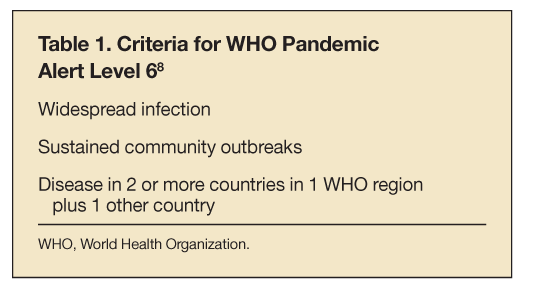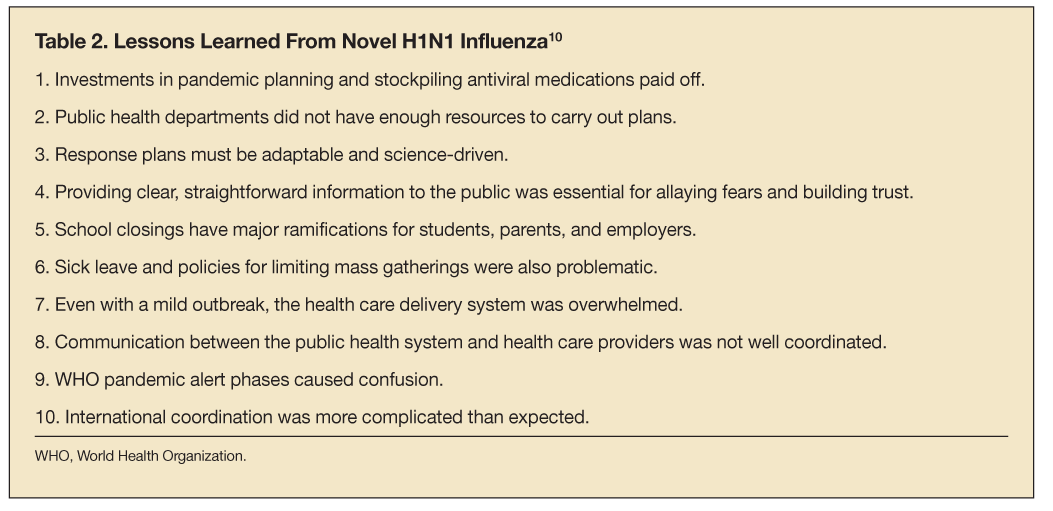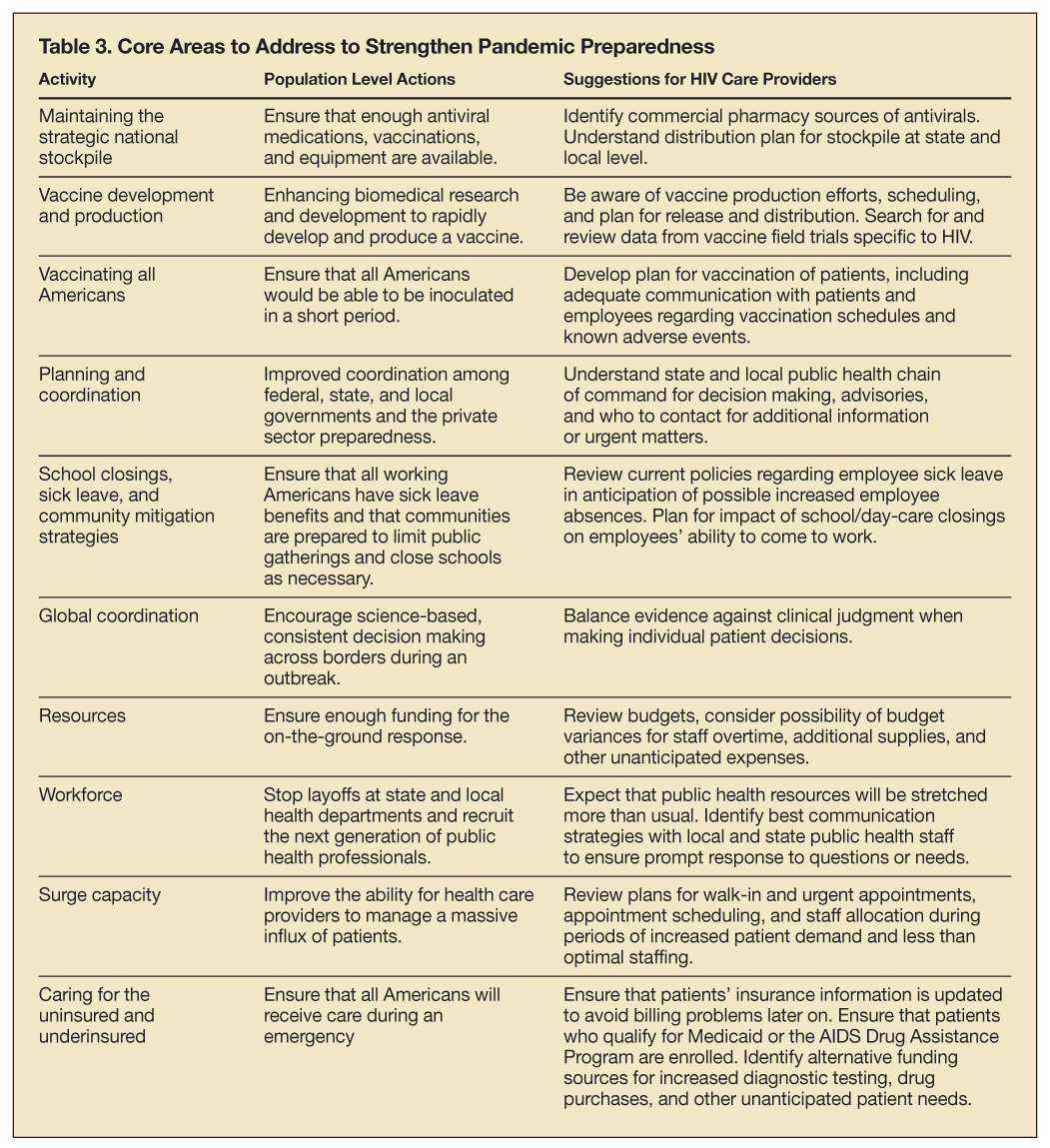HIV and Novel Influenza A (H1N1) Virus: A Call for Preparedness
Human infections with a novel influenza A (H1N1) virus were first identified in April 2009, with cases in the United States and Mexico. The epidemiology and clinical presentations of these infections are under investigation.
Human infections with a novel influenza A (H1N1) virus were first identified in April 2009, with cases in the United States and Mexico. The epidemiology and clinical presentations of these infections are under investigation. Insufficient data are available at this point to determine who is at higher risk for complications of this influenza A virus infection. Historically, however, adults and adolescents with HIV infection, especially persons with low CD4+ cell counts, are known to be at higher risk for viral and bacterial lower respiratory tract infections and for recurrent pneumonias. Using these data as a starting point, this discussion provides a brief status report on the current novel influenza A pandemic, with a focus on influenza preparedness for providers of HIV care.
Influenza and HIV
There are no data on the impact of the current novel strain of influenza A (H1N1) on persons with HIV/ AIDS. Evidence that influenza can be more severe for HIV-infected adults and adolescents comes from studies among HIV-infected persons who had seasonal influenza.1-5 Several studies from the early potent antiretroviral therapy era have reported higher hospitalization rates; prolonged illness; and increased mortality, especially among persons with AIDS.6,7
Thus, immunocompromised persons, including HIV-infected adults and adolescents and especially persons with low CD4+ cell counts or AIDS, can experience more severe complications of seasonal influenza. At this point, we can only speculate that HIV-infected adults and adolescents are also at higher risk for novel influenza A (H1N1) virus infection and its complications.
The duration of influenza symptoms is prolonged and the severity of influenza illness is increased among persons with HIV infection.1-5 A retrospective study of young and middle-aged women showed that the risk of cardiopulmonary hospitalizations among women with HIV infection was higher during influenza seasons than it was either before or after influenza was circulating. The risk of hospitalization was higher for HIV-infected women than it was for women with other underlying medical conditions.6
Another study estimated that the risk of influenza-related death was 94 to 146 deaths per 100,000 persons with AIDS, compared with 0.9 to 1.0 deaths per 100,000 persons aged 25 to 54 years and 64 to 70 deaths per 100,000 persons aged 65 years and older in the general population.7

Global Response
There are more than 30,000 confirmed cases of H1N1 influenza in 75 countries.8 Recently, the World Health Organization (WHO) raised the level of the influenza pandemic alert from phase 5 to phase 6, its highest designation.9 The WHO alert schema is based on the widespread geographic distribution of H1N1 influenza and not necessarily on virulence (Table 1). In this case, infection with novel influenza A (H1N1) virus is sufficiently widespread to warrant a level 6 alert. In addition, each level carries guidance with it for an appropriate public health response.9

Just before the revised WHO alert, the Trust for America’s Health and the Robert Wood Johnson Foundation issued an interim assessment of the US response to the emergence of novel H1N1 influenza.10 The 10 key points discussed in the report are shown in Table 2. The report highlights key preparedness issues and notes that much of the world’s pandemic planning had evolved from the potential threat of the avian H5N1 influenza virus, which had been circulating in Asia and elsewhere for nearly a decade.
While infections with avian H5N1 influenza virus continue to be reported, the emphasis has shifted to the unanticipated outbreak of novel H1N1 influenza. Either way, the report gives high marks to pandemic flu planning efforts and stockpiling of antiviral drugs that resulted in a more coordinated response once novel influenza A (H1N1) virus was identified.
As with any public health planning effort, not all assumptions proved to be correct, highlighting the need to be prepared to refine our response as we go along. For example, the authors reported that planners anticipated that there would be 6 weeks of lead time between the time a novel influenza virus was first identified and its spread to the United States. This was obviously an overestimate, since cases were identified in the United States concurrent with or even before H1N1 influenza was confirmed in Mexico, which was the pandemic’s epicenter.

The report makes recommendations for further strengthening of our pandemic preparedness (Table 3, columns 1 and 2). In column 3 of Table 3, I have made suggestions related to population-level actions in the report that have some relevance to HIV care providers.
In addition to assessing the overall public health preparedness in the United States, the report comments on the impact of H1N1 influenza on the health care delivery system, an area of interest to all health care providers, including those of us who care for HIV/AIDS patients. Obviously, the issue of surge capacity moves front and center in terms of our planning. Providing care for a larger number of patients during a period of an influenza outbreak becomes even more difficult at times of less than full staffing because of employee illness, transportation problems, or child care and family matters that prevent employees from working. At best, the recent efforts to contain novel H1N1 influenza was a “dress rehearsal” for what might come next, giving us some time to ensure that we are ready for the possible reemergence of novel H1N1 influenza in the future.
Assessing Preparedness
There is no single approach to preparedness. Pandemic influenza planning needs to take into account the nature of the HIV care program and the needs of patients. In addition, our planning needs to be integrated with the activities of our hospitals, local and state health departments, and other stakeholders.
All states have preparedness plans in place that are integrated with the federal response. Unfortunately, because these preparedness plans are based on certain assumptions in terms of pattern of spread and disease burden, they do not contain all the answers. Thus, we should also be prepared to make up some of the rules as we go along. As the report from the Trust for America’s Health indicates, links between public health and the health care delivery system still need to be strengthened. The New York State Health Department plan for pandemic preparedness provides one example of the public health response to pandemic influenza.11
The looming question is what the future holds for this novel H1N1 strain of influenza A virus. Because of the unpredictable nature of the influenza virus, the current pandemic may burn itself out over time. However, past pandemics offer some insight into what might unfold over the foreseeable future.
Our current emphasis on pandemic planning has its origins in the 1918 influenza pandemic.12 The pattern of influenza activity during the 1918 pandemic, also caused by the H1N1 strain, offers some insight into some possible future H1N1 influenza scenarios. Despite a considerable amount of epidemiological evidence accumulated since then, it is still not possible to determine the exact epicenter of the pandemic, although there is evidence of increases in influenza-like illness in European military camps as early as 1915. This was followed by 3 distinct waves of illness from 1918 to 1919. The first wave in the United States appeared around March 1918 and was relatively mild in terms of morbidity and mortality.
Two more aggressive waves came in the fall and winter of 1918 - 1919, presumably the result of viral reassortment to a more virulent strain. The conclusion from the public health community is to be prepared for additional disease rather than allowing ourselves to be unprepared.12
Infection Control Fundamentals
While many of our policies and procedures for contingency planning need to be reviewed, it is important not to lose sight of certain fundamentals. These include the infection control essentials such as hand washing with either soap and water or with alcohol-based hand sanitizers, and routine cleaning of the environment.
The centerpiece of our efforts lies in prevention with influenza vaccination. Vaccine manufacturing efforts for novel H1N1 are under way, but guidance in terms of vaccine distributions and schedules for vaccination is still forthcoming. At the time of this writing, it appears that the usual trivalent influenza vaccine (TIV) will be available in the fall of 2009, as well as a vaccine specific for H1N1.13,14
Influenza Vaccine and Persons With HIV
TIV produces adequate antibody concentrations against influenza viruses among vaccinated HIV-infected persons who have minimal AIDS-related symptoms and normal or near-normal CD4+ T-cell counts.15-17 Among persons who have advanced HIV disease and low CD4+ T-cell counts, TIV might not induce protective antibody titers17,18; a second dose of vaccine does not improve the immune response in these persons.18,19
A randomized placebo-controlled trial determined that TIV was highly effective in preventing symptomatic, laboratory-confirmed influenza virus infection among HIV-infected persons with a mean CD4+ T-cell count of 400/µL; however, a limited number of persons with CD4+ T-cell counts of less than 200/µL were included in that study.19 A nonrandomized study of HIV-infected persons determined that influenza vaccination was most effective among persons with CD4+ cell counts of more than 100/µL and among those HIV-1 RNA levels of less than 30,000 copies/mL.3
It makes sense to vaccinate HIV-infected persons with influenza vaccine and to be on the alert for febrile respiratory illness or influenza-like illness in our patients. The availability and use of antivirals (oseltamivir and zanamivir) will also be a part of our clinical response; guidance on antiviral therapy is ongoing,13 including the use of antivirals in pregnant women with HIV infection.20
Providers of HIV care need to know how and where to access antiviral drugs. In our own experience with the current outbreak of H1N1 influenza, our in-house pharmacy maintained a limited supply of oseltamivir and zanamivir for use in our patients. Fortunately, our demand did not exceed the supply, and our pharmacy has since ordered additional supplies.
Should the demand increase, antivirals would also be released from stockpiles held by state and local health departments.21 Antiviral distribution from stockpiles is a good example of the need for improved coordination and communication between the public health sector and providers.10 It is likely that the distribution systems vary by state and locality, but in our own experience, the system is not yet clearly outlined.
Summary The current novel H1N1 influenza A pandemic is evolving. The WHO has raised its pandemic alert level to level 6, indicating that we need to reassess our pandemic planning efforts. Guidance from the public health sector is being updated frequently and will provide a framework for our response. The job at hand for providers of HIV care is to first recognize that our patients may be at increased risk for morbidity and mortality due to this novel influenza virus strain. In addition, we need to be able to translate the available guidance to ensure the best possible outcomes for our patients.
References:
References
1. Safrin S, Rush JD, Mills J. Influenza in patients with human immunodeficiency virus infection. Chest. 1990;98:33-37.
2. Radwan HM, Cheeseman SH, Lai KK, Ellison RT III. Influenza in human immunodeficiency virus-infected patients during the 1997 - 1998 influenza season. Clin Infect Dis. 2000;31:604-606.
3. Fine AD, Bridges CB, De Guzman AM, et al. Influenza A among patients with human immunodeficiency virus: an outbreak of infection at a residential facility in New York City. Clin Infect Dis. 2001;32:1784-1791.
4. Couch RB. Influenza, influenza virus vaccine, and human immunodeficiency virus infection. Clin Infect Dis. 1999;28:548-551.
5. Tasker SA, O’Brien WA, Treanor JJ, Weiss PJ, et al. Effects of influenza vaccination in HIV-infected adults: a double-blind, placebo-controlled trial. Vaccine. 1998;16:1039-1042.
6. Neuzil KM, Reed GW, Mitchel EF Jr, Griffin MR. Influenza-associated morbidity and mortality in young and middle-aged women. JAMA. 1999;281:901-907.
7. Lin JC, Nichol KL. Excess mortality due to pneumonia or influenza during influenza seasons among persons with acquired immunodeficiency syndrome. Arch Intern Med. 2001;161:441-446.
8. World Health Organization pandemic alert. http://www.who.int/csr/ disease/swineflu/frequently_asked_questions/levels_pandemic_alert/en/ index.html. Updated June 11, 2009. Accessed June 15, 2009.
9. WHO pandemic phase descriptions and main actions by phase. http:// www.who.int/csr/disease/influenza/GIPA3AideMemoire.pdf. Accessed June 15, 2009.
10. The Trust for America’s Health. Pandemic flu preparedness: lessons learned from the frontlines. http://healthyamericans.org/reports/?reportid=64. Published June 2009. Accessed June 15, 2009.
11. New York State Department of Health. Pandemic flu preparedness. http://www.health.state.ny.us/diseases/communicable/influenza/ pandemic. Accessed July 20, 2009.
12. Taubenberger JK, Morens DM. 1918 Influenza: the mother of all pandemics. Emerg Infect Dis. 2006;12:15-22. http://www.cdc.gov/ncidod/EID/ vol12 no01/05-0979.htm. Accessed June 15, 2009.
13. Centers for Disease Control and Prevention. H1N1 flu (swine flu). http:// www.cdc.gov/h1n1flu. Accessed June 15, 2009.
14. Centers for Disease Control and Prevention. Interim guidance-HIV-infected adults and adolescents: considerations for clinicians regarding novel influenza A (H1N1) virus.
http://www.cdc.gov/h1n1flu/guidance_HIV. htm. Published June 5, 2009. Accessed June 15, 2009. 15. Chadwick EG, Chang G, Decker MD, et al. Serologic response to standard inactivated influenza vaccine in human immunodeficiency virus-infected children. Pediatr Infect Dis J. 1994;13:206-211.
16. Huang KL, Ruben FL, Rinaldo CR Jr, et al. Antibody responses after influenza and pneumococcal immunization in HIV-infected homosexual men. JAMA. 1987;257:2047-2050.
17. Staprans SI, Hamilton BL, Follansbee SE, et al. Activation of virus replication after vaccination of HIV-1-infected individuals. J Exp Med. 1995;182:1727-1737.
18. Kroon FP, van Dissel JT, de Jong JC, et al. Antibody response after influenza vaccination in HIV-infected individuals: a consecutive 3-year study. Vaccine. 2000;18:3040-3049.
19. Miotti PG, Nelson KE, Dallabetta GA, et al. The influence of HIV infection on antibody responses to a two-dose regimen of influenza vaccine. JAMA. 1989;262:779-783.
20. Centers for Disease Control and Prevention. Pregnant women and novel influenza A (H1N1): considerations for clinicians. May 7, 2009. http://www. cdc.gov/h1n1flu/clinician_pregnant.htm. Accessed June 15, 2009.
21. Centers for Disease Control and Prevention. CDC health update: swine influenza A (H1N1) update: new interim recommendations and guidance for health directors about strategic national stockpile material. http://www. cdc.gov/h1n1flu/HAN/042609.htm. Published April 26, 2009. Accessed June 15, 2009.
Other Resources General information
Access to US government H1N1, avian and pandemic flu information. http://www.pandemicflu.gov. Accessed June 15, 2009. Daily Updates Novel Influenza-World Health Organization. http://www. who.int/csr/don/en. Accessed June 15, 2009.
Influenza vaccination
Centers for Disease Control and Prevention. Prevention and control of influenza: recommendations of the Advisory Committee on Immunization Practices (ACIP), 2008. MMWR. 2008;57(RR-7):1-60. http://www.cdc.gov/ mmwr/PDF/rr/rr5707.pdf. Accessed June 15, 2009. Swine flu: mapping the outbreak. http://news.bbc.co.uk/2/hi/americas/ 8021547.stm. Updated June 4, 2009. Accessed June 15, 2009.
Infection control guidance
Centers for Disease Control and Prevention. Interim guidance for infection control for care of patients with confirmed or suspected novel influenza A (H1N1) virus infection in a healthcare setting. http://www.cdc.gov/ h1n1flu/ guidelines_infection_control.htm. Accessed June 15, 2009.
Pregnant women
Centers for Disease Control and Prevention. Novel influenza A (H1N1) virus infections in three pregnant women-United States, April-May 2009. May 12, 2009/58(Dispatch);1-3. http://www.cdc.gov/mmwr/preview/mmwrhtml/ mm58d0512a1.htm. Accessed June 15, 2009.